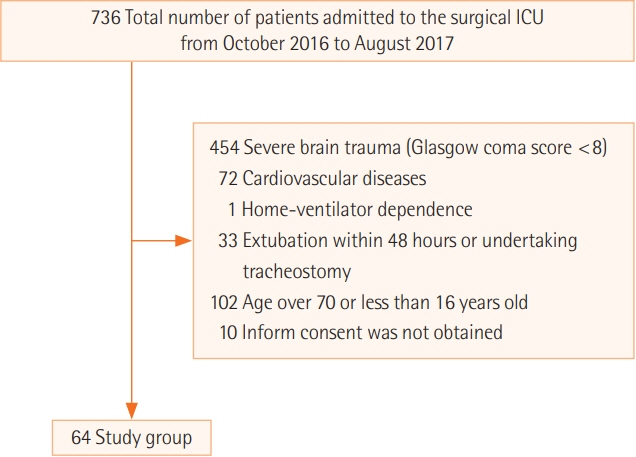Acute Crit Care.
2020 Nov;35(4):279-285. 10.4266/acc.2020.00598.
Predictive value of the negative inspiratory force index as a predictor of weaning success: a crosssectional study
- Affiliations
-
- 1Department of Anesthesia and Intensive Care, Hanoi Medical University, Hanoi, Vietnam
- 2School of Population Health, University of New South Wales, Sydney, Australia
- KMID: 2510547
- DOI: http://doi.org/10.4266/acc.2020.00598
Abstract
- Background
Identifying when intubated patients are ready to be extubated remains challenging. The negative inspiratory force (NIF) is a recommended predictor of weaning success. However, little is known about the role of NIF in the weaning process for the Asian surgical intensive population, especially for the Vietnamese population. Here, we aimed to investigate the cutoff threshold and predictive value of the NIF index for predicting the success of ventilator weaning in Vietnamese surgical intensive care patients.
Methods
A cross-sectional study was conducted at the Surgical Intensive Care Unit of Viet Duc Hospital from October 2016 to August 2017. A total of 64 patients aged 16–70 years undergoing ventilatory support through an orotracheal tube satisfied the criteria for readiness to begin weaning. The correlation between the NIF index with outcomes of the weaning process was analyzed. Specificity (Sp), sensitivity (Se), positive predictive value (PPV), negative predictive value (NPV), receiver operating characteristic (ROC) curve, and area under the curve (AUC) were calculated.
Results
The success rate of the entire weaning process was 67.2% (43/64). The median NIF values were –26.0 cm H2O (interquartile range [IQR], –28.0 to –25.0) in the successful weaning group and –24.0 cm H2O (IQR, –25.0 to –23.0) in the weaning failure group (P<0.001). According to ROC analysis, an NIF value ≤–25 cm H2O predicted weaning success (AUC, 0.836) with 91% Se, 62% Sp, 83% PPV, and 77% NPV.
Conclusions
An NIF cutoff threshold ≤–25 cm H2O can be used as predictor of weaning success in Vietnamese surgical intensive care patients.
Keyword
Figure
Reference
-
1. Lone NI, Walsh TS. Prolonged mechanical ventilation in critically ill patients: epidemiology, outcomes and modelling the potential cost consequences of establishing a regional weaning unit. Crit Care. 2011; 15:R102.
Article2. Hess D, Kacmarek R. Essentials of mechanical ventilation. 3rd ed. Ohio: McGraw-Hill Medical;2014.3. Nemer SN, Barbas CS. Predictive parameters for weaning from mechanical ventilation. J Bras Pneumol. 2011; 37:669–79.4. Stawicki SP. ICU corner: mechanical ventilation: weaning and extubation. OPUS 12 Sci. 2007; 1:13–6.5. Béduneau G, Pham T, Schortgen F, Piquilloud L, Zogheib E, Jonas M, et al. Epidemiology of weaning outcome according to a new definition. The WIND Study. Am J Respir Crit Care Med. 2017; 195:772–83.
Article6. Boles JM, Bion J, Connors A, Herridge M, Marsh B, Melot C, et al. Weaning from mechanical ventilation. Eur Respir J. 2007; 29:1033–56.
Article7. Kulkarni AP, Agarwal V. Extubation failure in intensive care unit: predictors and management. Indian J Crit Care Med. 2008; 12:1–9.8. Medrinal C, Prieur G, Combret Y, Quesada AR, Bonnevie T, Gravier FE, et al. Reliability of respiratory pressure measurements in ventilated and non-ventilated patients in ICU: an observational study. Ann Intensive Care. 2018; 8:14.
Article9. Bien Udos S, Souza GF, Campos ES, Farah de Carvalho E, Fernandes MG, Santoro I, et al. Maximum inspiratory pressure and rapid shallow breathing index as predictors of successful ventilator weaning. J Phys Ther Sci. 2015; 27:3723–7.
Article10. Macintyre NR. Evidence-based assessments in the ventilator discontinuation process. Respir Care. 2012; 57:1611–8.
Article11. Charan J, Biswas T. How to calculate sample size for different study designs in medical research? Indian J Psychol Med. 2013; 35:121–6.
Article12. Thille AW, Richard JC, Brochard L. The decision to extubate in the intensive care unit. Am J Respir Crit Care Med. 2013; 187:1294–302.
Article13. Chang DW. Clinical application of mechanical ventilation. 4 ed. Clifton Park: Cengage Learning;2013.14. Zein H, Baratloo A, Negida A, Safari S. Ventilator weaning and spontaneous breathing trials: an educational review. Emerg (Tehran). 2016; 4:65–71.15. Rapsang AG, Shyam DC. Scoring systems in the intensive care unit: a compendium. Indian J Crit Care Med. 2014; 18:220–8.
Article16. McGee S. Simplifying likelihood ratios. J Gen Intern Med. 2002; 17:646–9.
Article17. Godard S, Herry C, Westergaard P, Scales N, Brown SM, Burns K, et al. Practice variation in spontaneous breathing trial performance and reporting. Can Respir J. 2016; 2016:9848942.
Article18. Artime CA, Hagberg CA. Tracheal extubation. Respir Care. 2014; 59:991–1002.
Article19. Ebrahimabadi S, Moghadam AB, Vakili M, Modanloo M, Kho ddam H. Studying the power of the integrative weaning index in predicting the success rate of the spontaneous breathing trial in patients under mechanical ventilation. Indian J Crit Care Med. 2017; 21:488–93.
Article20. Delisle S, Francoeur M, Albert M, Ouellet P, Bellemare P, Arsenault P. Preliminary evaluation of a new index to predict the outcome of a spontaneous breathing trial. Respir Care. 2011; 56:1500–5.
Article21. Qing Q, Liang M, Sun Q, Xie B, Yang C, Liang W, et al. Using twitch tracheal airway pressure, negative inhale forced pressure, and Medical Research Council score to guide weaning from mechanical ventilation. J Thorac Dis. 2018; 10:4424–32.
Article22. Ko R, Ramos L, Chalela JA. Conventional weaning parameters do not predict extubation failure in neurocritical care patients. Neurocrit Care. 2009; 10:269–73.
Article23. Conti G, Montini L, Pennisi MA, Cavaliere F, Arcangeli A, Bocci MG, et al. A prospective, blinded evaluation of indexes proposed to predict weaning from mechanical ventilation. Intensive Care Med. 2004; 30:830–6.
Article
- Full Text Links
- Actions
-
Cited
- CITED
-
- Close
- Share
- Similar articles
-
- Weaning Approach with Weaning Index for Postoperative Patients with Mechanical Ventilator Support in the ICU
- Clinical Use of Weaning Indices from Mechanical Ventilation in Surgical Intensive Care Unit Patients
- Comparison of Initial Weaning Success Rates and Weaning Periods between Synchronized Intermittent Mandatory Ventilation and Pressure Support Ventilation
- Role of Bedside Ultrasonography in Assessment of Diaphragm Function as a Predictor of Success of Weaning in Mechanically Ventilated Patients
- A Comparison of Clinical Efficacy of Weaning Method Between the Mode of Intermittent Mandatory Ventilation and Intermittent Mandatory Ventilation Plus Pressure Support




